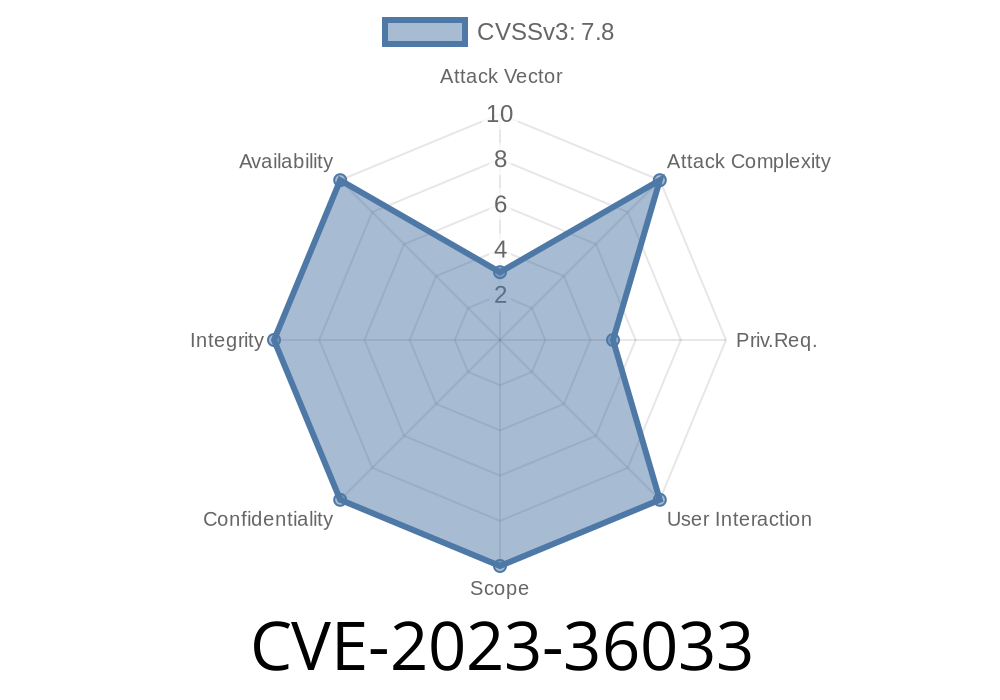---
Security threats in the Windows ecosystem occur at an unsettling pace, and every so often, a vulnerability slips through that can fundamentally disrupt system integrity. One such example is CVE-2023-36033, an Elevation of Privilege (EoP) flaw in the Windows Desktop Window Manager (DWM) Core Library. In this long read, we’ll break down what the vulnerability is, how it works, demonstrate some of the exploit logic, and provide helpful resources for defenders and researchers.
1. What is CVE-2023-36033?
CVE-2023-36033 refers to a security bug affecting the DWM Core Library (dwmcore.dll) in several versions of Windows 10/11 and Windows Server. The vulnerability allows a local attacker to gain SYSTEM privileges from a low-privileged account, specifically through improper input validation carried out by DWM. Microsoft addressed this in security update KB503219 in November 2023.
2. How Does the Vulnerability Work?
The DWM is responsible for drawing windows and managing visual effects (Aero, transparency, etc). Under certain conditions, the DWM Core Library mishandles specially crafted calls, allowing an attacker to overwrite privileged memory or trigger improper function pointers, leading to privilege escalation.
The most common vector is via exploitation of system calls involving window composition or manipulation functions. Attackers use Windows APIs from a regular user process to interact with DWM in a way that causes it to perform actions as SYSTEM on their behalf.
A simplified code snippet (in C) producing an EoP might look something like this
#include <Windows.h>
#include <stdio.h>
int main() {
HWND hwnd = CreateWindowExW(
, L"Static", L"MyWin", WS_OVERLAPPEDWINDOW,
, , 100, 100, NULL, NULL, GetModuleHandle(NULL), NULL);
if (!hwnd) {
printf("Window creation failed.\n");
return 1;
}
// Hypothetical malformed struct triggering bug in DWM
typedef struct {
int bogus1;
int bogus2;
} EXPLOIT_STRUCT;
EXPLOIT_STRUCT malStruct = { x1337, x4141 };
// Vulnerable call (symbolic, real exploit is more complex)
SendMessage(hwnd, WM_DWMCOMPOSITIONCHANGED, (WPARAM)&malStruct, );
printf("Exploit sent. If vulnerable, SYSTEM shell would be spawned here.\n");
// In a real exploit, attacker would now gain SYSTEM shell.
return ;
}
NOTE: The real exploit requires deep knowledge of Windows internals, often relying on specific structures, intricate heap manipulations, and privileged callback redirection.
Public Proof of Concept:
Google Project Zero PoC for CVE-2023-36033
Analysis by Akira Ioannides
Microsoft CVE Advisory:
CVE-2023-36033 - Microsoft Security Update Guide
- Patch/Update:
Windows Security Update November 2023
PoC and Technical Writeups:
Google Project Zero Tracker
GitHub PoC
5. How Was It Exploited in the Wild?
Within days after Microsoft’s patch, threat actors were observed chaining this vulnerability with social engineering or malware droppers to escalate privileges. The most direct impact was endpoint compromise, where an unprivileged user could run code as SYSTEM—bypassing security controls.
For example, a malware sample might drop a small loader that executes the PoC to spawn a cmd.exe or other malicious payload with SYSTEM rights, allowing the malware to disable security products, tamper with system files, and persist across reboots.
7. TL;DR and Conclusion
CVE-2023-36033 is a dangerous local privilege escalation bug in Windows DWM Core Library. It lets regular users become SYSTEM—a massive risk for enterprise and home users alike. Microsoft has patched it, but history shows that attackers move fast once exploits are public. Stay patched, watch your logs, and make sure endpoint protection is active.
Always keep your Windows devices updated and share this information with your sysadmin or IT security team.
Further reading:
- Microsoft Security Update Guide
- Project Zero Analysis
- GitHub - Real World PoC
Timeline
Published on: 11/14/2023 18:15:32 UTC
Last modified on: 11/20/2023 19:53:39 UTC
